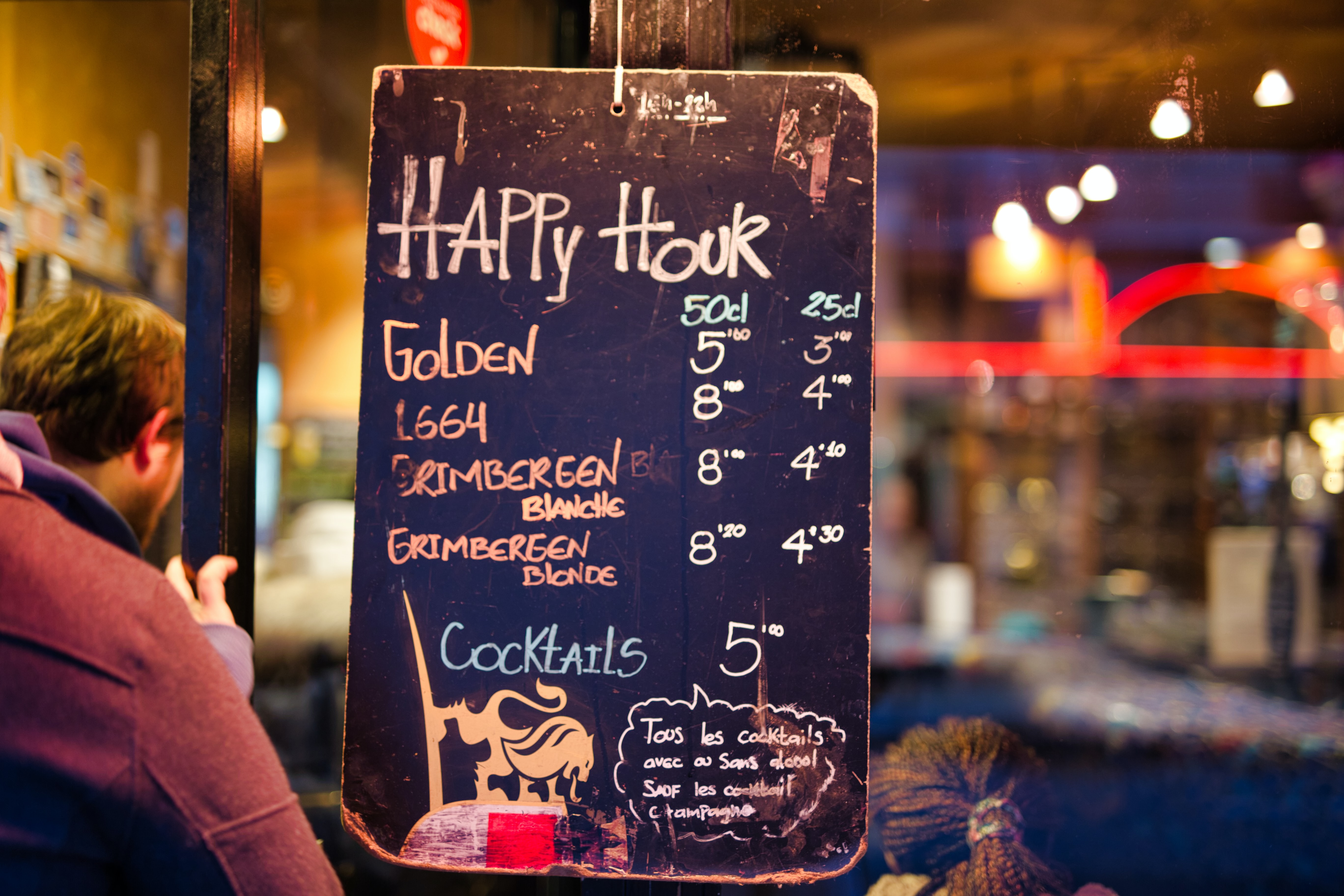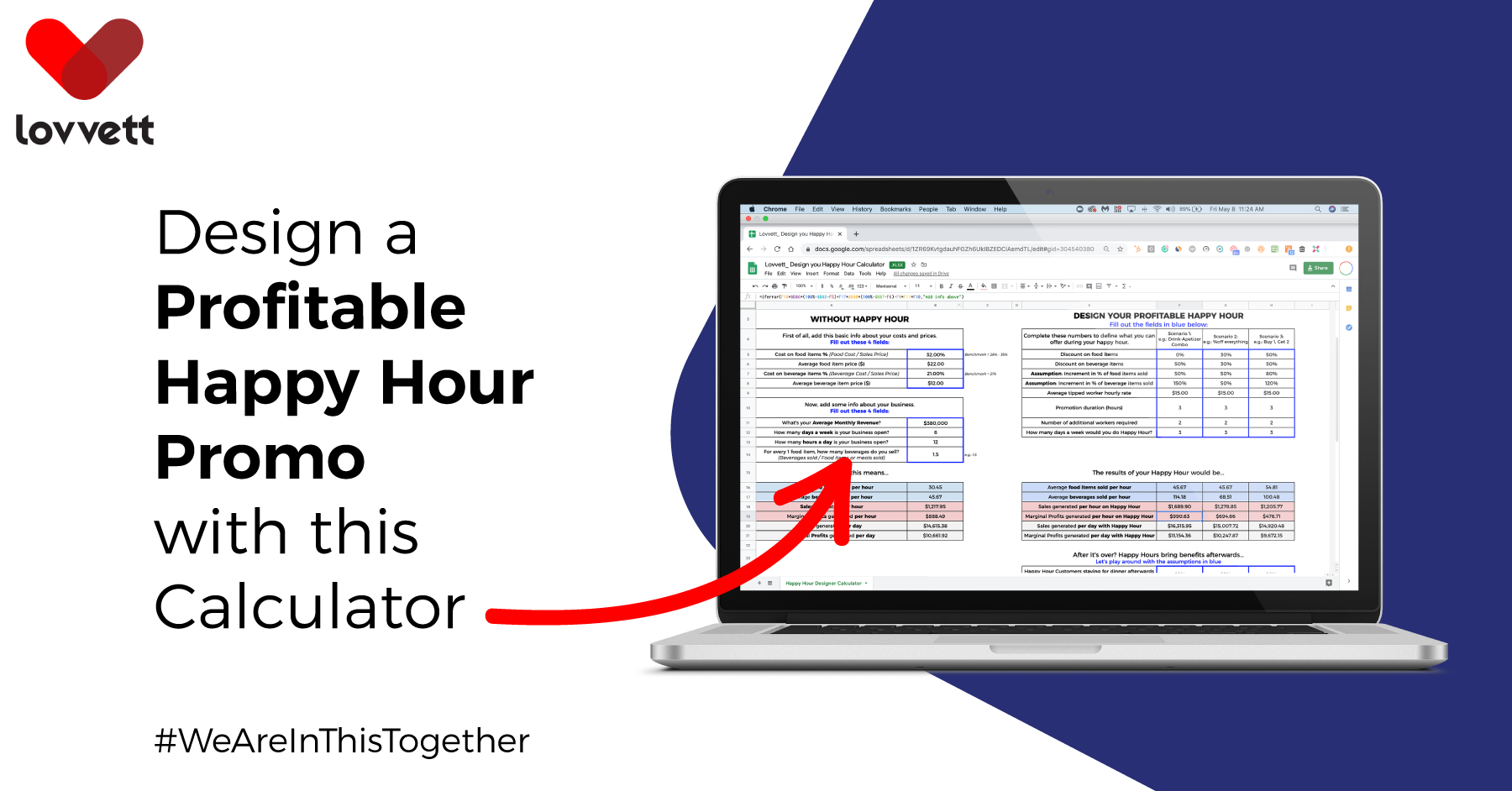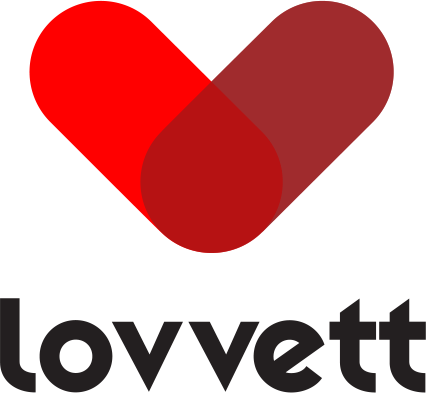 You may have been considering introducing a happy hour or running a flash sale before the start of the coronavirus pandemic. Perhaps you were in the process of considering them as an option to increase sales and revenue at slower periods. Well, now there’s even more reason to try it out and see if it could benefit your business.
You may have been considering introducing a happy hour or running a flash sale before the start of the coronavirus pandemic. Perhaps you were in the process of considering them as an option to increase sales and revenue at slower periods. Well, now there’s even more reason to try it out and see if it could benefit your business.
Whether they’re under an official lockdown or practicing self-quarantine, people who are cooped up at home are looking for ways to treat themselves. Marketing consumer insights research by Klaviyo has revealed that “The more time employed people spend living under stay-at-home guidelines, the more they start to buy impulsively.”
And what’s harder to resist than a bargain? Limited or time-sensitive offers like happy hours and flash sales are a tried and tested way of boosting sales. They trigger our Fear of Missing Out (FOMO) and force us to act right now! However, increased transactions don’t necessarily mean increased revenue. It’s important to strategize.
This blog contains key information to help you decide whether a happy hour or flash sales could work for your food and retail business. We’ve included a calculator to help you devise an offer that will entice customers while also bringing in more revenue.
1. Happy Hour, Flash Sales & Dynamic Pricing
Happy Hour
If your business sees a regular dip in sales at certain times of the day or on certain days of the week, happy hour could help even things out and bring you extra income.
Traditionally speaking, happy hour occurs between 4-7pm when there is typically less traffic in bars and restaurants. They can occur on any day of the week, but midweek is the most popular as it tends to be when footfall is particularly low.
In restaurants, drinks have the highest markups, so it’s fairly simple to create offers that can reliably increase revenue. But nowadays, it’s not just great deals on drinks that are attracting customers. Pair drinks with appetizers or sliders to maximise sales and revenue.
The concept of offering deals at off-peak hours to create a steady stream of income isn’t limited to restaurants and bars. Any periodical business can benefit from such offers. For example, cafes and bakeries are typically more popular in the morning. By the afternoon, the unsold pastries are likely to go to waste. Creating a happy hour for your bakery might be an excellent way to make extra profit from goods that are otherwise destined to be discarded.
Happy hour deals are a great way of attracting regular custom. It will bring in customers who otherwise might have overlooked your establishment, and also encourage regulars to make an extra off-peak visit.
Flash Sales
While happy hour is a great solution for businesses that see regular dips in sales across the week, flash sales are a little different. Unlike happy hour, flash sales are sporadic. Part of their success is their unpredictability. If customers don’t know when your next sale will be, they’ll be more tempted to make that impulse purchase.
Flash sales are particularly worthwhile for businesses that operate seasonally. For example, florists, whose businesses center around special occasions, will be slower at certain times of the year. Offering flash sales will keep sales ticking over during these times. They’ll also ensure that your business is fresh in the minds of your clients the next time they need flowers for a special occasion.
Another benefit of a flash sale is that there is no ongoing obligation. You can choose to launch a flash sale as and when it suits your business. There is no commitment to repeat the offer in subsequent weeks.
Dynamic Pricing
So to recap so far:
- Happy Hour is great for businesses that experience dips at certain times of the day and on certain days of the week.
- Flash sales are a good option for businesses that operate seasonally, and experience dips at certian times of the year.
Dynamic pricing is a third option that accounts for both, and it’s increasingly popular with restauranteurs. Prices change throughout the day, throughout the week and throughout the year to accommodate changing demand. We’re, of course, used to this kind of pricing from airlines, but can it work for restaurants?
“Surge pricing” can have negative connotations, linking it to that time Uber drivers were caught hacking the system, or overpriced airline tickets. But dynamic pricing has evolved in the restaurant industry to offer customers to get a bargain while restauranteurs enjoy increased revenue to help cover their running costs during quieter periods.
In early 2018, chic London restaurant Bob Bob Ricard started a dynamic pricing system: 25% off for off-peak hours, and 15% off for mid-peak hours. They found that “the number of customers has nearly doubled during the quietest times”.
For fine dining restaurants, dynamic pricing works well for the simple reason that the coveted experience of dining somewhere fancy is opened up to a new set of aspiring diners. But can it work for more humble establishments?
The Vegetable Biryani at New York’s Indian street food restaurant Desi Galli retails at $10.99 (at time of writing). Owner PriaVanda Chouhan uses dynamic pricing to drop her afternoon prices by 15-20%. She also plays around with which items are discounted to help shift slow-moving ingredients and keep food waste to a minimum.
With a number of apps, including Lovvett, in the process of offering dynamic pricing, it’s worth serious consideration to help increase sales at slower times. We’re also excited to be able to offer dynamic pricing to bakers and fresh produce vendors such as grocers and florists. There is a lot of untapped potential with this new pricing method to help boost sales in industries whose stock has an expiry date.
2. Types of offers
30% off, 2 for 1, free desert: one big decision that will greatly affect your sales and your revenue is what type of offer to put on. You need to make the offer tempting enough to entice customers, but still profitable enough to be worth the extra work. If, for example, you offer everything at half price and make double the sales, you’re no better off.
Finding that balance is a challenge. Since there are so many variables, it’s impossible to know from the start what offers will work best for you and how much extra custom you’ll receive. However, you can give yourself a huge advantage by assessing your options and making an informed decision.
Here are a few different options and their benefits:
Drinks & Appetizers Combo
If you are in a state that permits it, drinks offers are a popular happy hour deal for bars and restaurants. There are a couple of main reasons for this:
- Drinks are generally marked-up higher than food, so it’s easier to create a generous offer that still reliably increases revenue.
- Unlike food, drinks require little to no preparation. Whatever you choose to put on offer will soar in popularity, and you need to make sure you account for extra staff if necessary. Creating offers on drinks puts labor costs to a minimum.
If you’re considering offering a deal on drinks, you might also consider creating an accompanying menu of appetizers or sliders that are cost-effective and require little preparation.
Research on Happy Hour deals by Technomic, Inc revealed that:
- While 46% of customers said they were attracted by special value on drinks, and 41% (almost as many) that great value food was what drew them in.
- 26% saw happy hour is a less expensive alternative to dinner at a restaurant
- Nearly as many (24%) said they might consider staying on for dinner.
Happy hour offers are a great way to draw in diners with an appetite. Not only can you increase bar sales, but you can also boost food sales by offering appetizers. Upsell your regular menu to encourage customers to stick around for dinner.
We’ve created a calculator to help you devise a combo that will suit your operations. You can download the calculator here for free. Read more about our calculator below.
Many establishments are now exclusively offering takeaway or delivery services during the coronavirus pandemic. Include them in happy hour deal, but just make sure you keep on top of laws regarding the sale of alcohol off-premises.
During the COVID-19 pandemic, some states are accomodating to allow for off-premises alcohol sales. However, take extreme care as they come with caveats.
In Florida, for example, governor Desantis signed an executive order temporarily permitting specially licensed restaurants to sell alcohol for consumption off-premises as long as they are sold in sealed containers, and so long as food is also included in the order.
These executive orders will expire, so it’s of utmost importance that you keep up to date and comply with all changes.
Percentage discount (e.g. 25% off everything)
If you have been consistent about setting healthy profit margins across all your dishes, you can offer a percentage discount on all of your products. In this instance, offering a % off discount makes it easy to calculate your increased earnings and profit margins - very helpful when assessing how successful your sale has been. From there you can test to see if other %off offers work equally well and find the perfect balance for your business.
They’re also popular with regular diners who want to have a full range of options from your menu. Regular customers will be reassured that their favorite item is included in the offer.
According to Krista Fabregas, a retail analyst at FitSmallBusiness.com, % off discounts produce one of the highest conversions for discounted promotions in the retail industry.
However, most establishments choose to vary the profit margins per product depending on how popular they are, how much labor they require and how much their competition is selling the same product for.
If your margins are uneven, you need to ensure you are compensated fairly. Consider creating a special menu which excludes dishes with narrower margins. Diners won’t be put off, as they are used to having a limited menu of deals.
2 for 1
2 for 1 offers, also known as BOGOF (Buy One Get One Free) are also appealing to customers. However, customers have wised up to the fact that BOGOF offers often come with many caveats that might make it less profitable than it originally seems. Transparency is key to maintaining the trust and confidence of your customers.
For example, make it clear - are you offering 2 for 1 on any combination of meals with the cheapest free? Or do customers have to order the same product?
2 for 1 is a good option if your aim is to shift surplus stock. If your stockist is offering a deal on their products, you might also want to pay it forward to your customers by offering a deal on specific meals or products.
You might think that offering BOGO-half-off would be better for revenue than BOGOF, but that’s actually not the case. As Fabregas explains:
“BOGO-half-off deals can frustrate customers since the deal always discounts the lower of the two prices. So, in BOGO-half-off, we tend to see lower revenues due to customers searching out the cheaper items for the BOGO pairings. BOGO-free converts better than the BOGO-half-off.”
3. Do they work?
In short, yes. Sales and offers, done well, can increase revenue substantially. Since there are so many variables, it’s impossible to give an exact figure or estimate as to how well they work across the board, but there are already plenty of reports and studies that testify to their success.
- One study revealed that bars experienced an average of 26% increase in revenue and a 24% increase in transactions during happy hour.
- The same study revealed that non-happy hour bars which ordinarily generate 10% more revenue were still outperformed by happy hour bars by more thatn 20% during happy hour.
- A case study by the University of Nevada showed that revenue from bar sales doubled in the first hour of a happy hour event.
- Analysis by Neilsen states that “U.S. bars and restaurants generate 60.5% of their average weekly sales from Happy Hour—just 15 hours of the total business week.”
- After adopting dynamic pricing, Bob Bob Ricard nearly doubled customers at quieter times.
- PriaVanda Chouhan used the increased revenue resulting from her dynamic pricing strategy to cover the $1.50 minimum wage rise for her staff at Desi Gali.
But simply creating an offer doesn’t guarantee results. You need to calculate, strategize, trial and adapt to find what works best for your establishment.
4. Calculate and Create a Special Menu
Unless you are planning to create a blanket deal across all of your products, you’ll need to strategize to decide what to discount and what to exclude from your special offers menu.
You can’t afford to simply use intuition. It’s time to get your calculator out. For example, many people make the mistake on only offering discounts on lower-priced items, but all that does is incentivize people to buy lower priced items and spend even less money - not great for revenue.
Another common mistake is not to factor in labor costs. When planning your happy hour/flash sale menu, expect that your sales will double. If you include labor-intensive dishes that require intricate preparation, you’ll probably need extra staff on shift. Paying their wages offsets the profit gained by running the event in the first place. Until you can be guaranteed a great increase in revenue, keep labor costs to a minimum.
To help you understand your options, we’ve created a this calculator to help you decide what kind of happy hour deal will work best for your establishment.
.png?width=600&name=Lovvett_HappyHour-Screenshot-v2-(for-Mockup).png) Click here to download the Profitable Happy Hour Calculator
Click here to download the Profitable Happy Hour Calculator
Estimates are conservative and are based on your current sales presuming your marketing and your staff can successfully upsell sales of drinks and appetizers. Bear in mind that with good marketing you can increase your predicted sales substantially. You can increase the accuracy of predicted sales and revenue by holding customer surveys or buy running trials. We recommend this before committing to a regular deal.
5. How to market special offers
It’s fundamentally important to have a digital presence these days. Especially during and post the coronavirus pandemic.
Old hat tactics of promoting happy hour deals, such as leafletting, no longer cut it. 10 years ago, dedicated flash-sale sites such as Groupon were a good option, but fewer people are using such sites. Times have moved on.
- The first thing to do is to leverage your social media channels. Make sure you repeatedly post happy hour deals each week as your current customer base gets acquainted with your new deals.
- Brainstorm marketable ideas. Get creative and think about your establishment can fit around the changing needs and desires of your customer base.
Industry insights company McKinsey & Company have revealed that experience-related services have boomed in recent years. This is great news for food and restaurant industry. There are plenty of ways to create experiences for your customers. For example, bakeries can offer afternoon tea deals for Mother’s Day. You could partner up with local brands for perculiar events: Logan Arcade in Chicago teams up with Metropolitan Brewing to host an annual robot-building class. How intriguing! - Third Party apps currently lack the functionality to allow you to promote your special offers. Lovvett wants to change that. We’re establishing ourselves as the go-to app for conscious consumers to patronize local and beloved establishments while also seeking a bargain for themselves.
Though there are statistics to back up the success of flash deals and happy hours, you need to make sure that you’re strategic and clever about it to make them work for you. Sign up for our calculator to help you decide what offers would best suit your business and create a personalized menu to maximise revenue.
Keep in touch with us at Lovvett.com to learn more as we unroll our app targeting people looking to support your business off-peak and find out if dynamic pricing is an option for your business.








.png) by lovvett ® 2020
by lovvett ® 2020